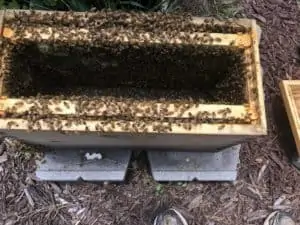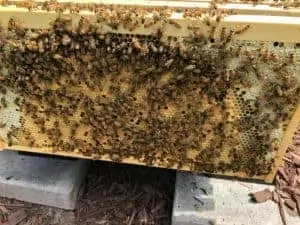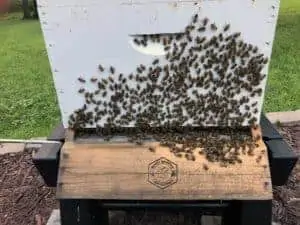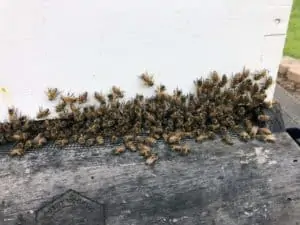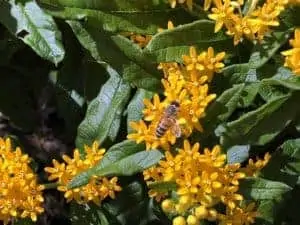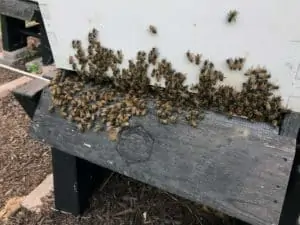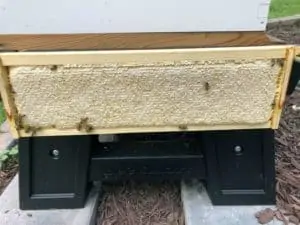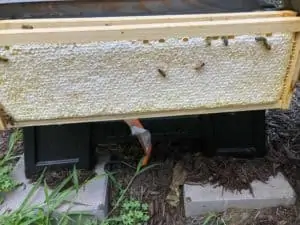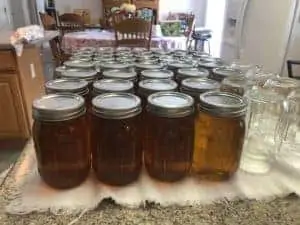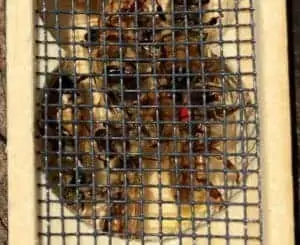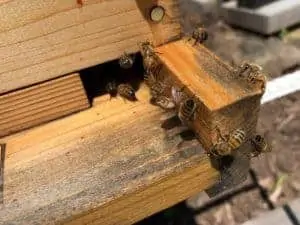Faithful readers, you have my sincerest apology for the long hiatus from posting. I had some new job duties associated with our corporation’s annual User Conference that really ate all of my time in June and early July. Then I became ill towards the end of that conference.
Needless to say, I have missed posting about progress in my colonies and there is much to share. Since my last post, I have placed honey supers and have now harvested honey. So let’s get along to those hive updates.
Hive Updates
Since the collapse of my Buckfast experiment, a lot of changes have been taking place in my apiary. I was definitely looking forward to harvesting my first honey from my new hobby and was curious to see if I could manage to handle Varroa Mites better this year. Unfortunately for us here in western North Carolina, it has been a very rainy summer.
The rains started late in May and have continued all through the summer. We had one ten day period where it rained every day for most of each day, which coincided with the Tulip Poplar blooms which kicks off the spring honey flow for us. That ten-day rain also hit right about the time my first queens emerged in the nucleus colony I split from Hive Aquitaine. In fact, it seems every time queens were emerging in this nucleus colony we would have a period of rain keeping the queen confined until it was too late. Alternatively, she would never make it back to the hive. I think I have experienced both issues this year. That has been probably the most frustrating element of my beekeeping season this year.
My last post a little under two months ago had me close to selling my first nucleus colony. So, let me update you on that tidbit of news.
I decided after some well-placed advice to re-queen that colony with a new queen prior to letting it depart my apiary. I located and installed the new queen and had my purchaser wait until I was sure she had been released before picking up the colony. Once I knew she was released and active in the colony, I packaged up the nuc for him.
This was our second attempt at a nuc for this guy. The first nuc absconded when he put Formic Pro on to treat for Varroa Mites and the temperatures got too hot. So this was the second attempt at getting him a nuc. All I asked for this nuc was payment for the queen replacement as there were just as many worker bees as there were with the first re-queened nuc I had sold him.
I told him to hold off on paying for the replacement queen until we were sure her laying pattern was solid. So, two weeks later he performed a hive inspection and it revealed a beautiful laying pattern in the colony. My first sale from my new hobby was for a nucleus colony helping out a beekeeper who didn’t think he would be able to replace his bees that he lost. All in all, that made me feel pretty darned good, even though I didn’t make what I would normally make on the sale of a nuc.
My apiary, now has four hives and one nucleus colony. All of the primary hives are doing exceptionally well. Hives Aquitaine, Florence, Rome, and Asgard are growing but some of these colonies are much stronger than others.
For instance, both Hive Florence and Rome and burgeoning with worker bees. Hive Florence has a Carniolan queen who has done an exceptionally great job of filling the colony full of workers. Hive Rome has a VSH Italian queen who has done equally well at building up the colony, but has recently slowed down production as we enter the summer dearth.
Hive Aquitaine
Hive Aquitaine has been the biggest disappointment this summer. Early in the summer, I had a mishap with Eleanor who I was attempting to raise queens from and apparently while the honey supers were on she expired and the colony did not replace her.
Seeing activity in this hive dropping off, I had a clue that there was a queen issue and decided to get into the hive and check up on it. The honey supers were largely untouched which is a clear sign of a queen issue. Colonies just aren’t productive when they are lacking the cohesiveness of purpose aided by a healthy queen.
As I examined the upper and lower brood boxes, I discovered small amounts of capped brood, no eggs, and no larvae. I knew then that I had a problem on my hands and as I was leaving in a couple of days for a ten day period I also knew I had to act quickly. I located a replacement queen and installed her two days before my departure. I knew there was no way I would know whether or not they had released her until I returned home. I don’t do well with not knowing what is going on in my apiary especially after installing a new queen, so this was a long wait for me!
After I returned, I was able to open the colony and check up on the queen to see if she had been released. She had and had already begun the re-population efforts in the colony. I did not take the time to mark her as I was fearful of disturbing this colony too much. I did take the time to check every frame and can say that it is time to start feeding as the colony is eating into its honey stores for winter. Feeding will commence this week.
Hive Asgard
Hive Asgard, my would-be Buckfast colony, is now firmly an Italian colony and couldn’t be more docile and easy to work. The colony has increased in size quite nicely and although it isn’t quite as large as Hive Florence or Hive Rome it is definitely beginning to get closer to those two colonies. I did not super this colony this year as it is a new colony and I firmly believe leaving the honey to my bees last winter helped them tremendously in coming through a colder winter than we had had in a few years. Moral of this story, when what you’re doing is working, keep doing it!
Freyja was wondering along one of the brood frames and continues to produce large quantities of brood. What I am noticing, from all three of my VSH queens, is that the bees are indeed hygienic. The amounts of Varroa Mite infestations are definitely lower than they were this time last season and the evidence of hygienic removal of brood is evident on the frames with open slots where brood had been that are not emerging brood but brood removed due to the presence of Varroa Mites.
I am definitely beginning to love these hygienic queens because it is making Varroa management much easier. So after an initial rough patch with a less-than-friendly hive, this colony has ended up becoming a docile angel. They actually let me work this hive in just a shirt and jeans. I had the suit ready if I needed to make a quick escape but given the heat wanted to give it a try. They didn’t even offer to sting me, which is quite a statement after what I described from early in the season. I have docile Valkyries now!!
Hive Florence
The Carniolan queen in this colony took a short while earlier in the summer to begin bulking up. This colony came out of winter badly bruised because of Varroa Mites. A frame of mostly capped brood from Hive Aquitaine gave it the necessary jump start and then the replacement of the queen with a new Carniolan provided all the extra impetus needed to get things moving in this colony.
This colony is easily the largest colony I have in my apiary, with the bees frequently seen in the evenings congregating at the entrance looking out at their keeper (see the picture of the masses of bees!). I love this queen. She is a dark, dark chocolate brown and very active wondering around the frames. Again, this colony didn’t strengthen in time to take advantage of the much abbreviated chance at a honey flow but did create some honey. It just wasn’t capped and available for removal. I ended up letting the colonies rob the small amount of honey that was present.
The long delay between when I supered the colonies and when I removed the supers and resumed inspections was a bad idea. I will never again let my colonies go six or seven weeks without an inspection. The workers had literally drawn comb between the medium and upper brood box and it was so solidly constructed I had a two hour of job of inspecting the colony, removing burr comb and getting everything back into proper order.
The good news is that even in this Carniolan colony there isn’t an overabundance of Varroa Mites present. And absolutely no evidence of deformed wing virus or other typical vectors of varroa mites.
All things considered, despite a disappointing honey flow period, I’m pleased that I look to be moving into a stronger spring season next year.
Hive Rome
This colony is as large if not equally sized to Hive Florence. It also evidences lots of happy worker bees residing at the entrance late in the evenings staring out at the strange human bemusedly observing them.
Just like Hive Florence, this colony had built tons of burr comb between the medium and upper brood boxes. And similarly, it was a multi-hour job of cleaning up the mess. But with that accomplished, I found a very happy queen wondering around creating a solid brood pattern and keeping this colony humming along.
What is concerning with this colony is that they are building queen cups in the swarm position all along the bottoms of the frames in all three boxes. I must have removed closed to 30 in this colony alone. I even found two in supersedure position all unoccupied.
I found much the same in Hive Florence but not to the degree they are present in Hive Rome. I am likely going to split both Hive Florence and Rome and queen the splits as soon as I get my resource hive painted (this week!).
What this colony did, that none of my other colonies managed, was producing two full supers of honey! I ended up with 5 gallons of honey produced from this one colony which has been packaged up into pints and half-pints for this season. So, I got to experience the process of uncapping with an uncapping knife, saving the cappings for wax production (putting them in a panty hose and hanging near the apiaries for the bees to clean out the excess honey works like a charm!), and running the extractor. I also learned how to strain the honey to remove any remaining cappings which was an experience.
Three days of madness and lots of bottles of honey later, I have a somewhat light, very sweet honey that has a little bit of a tangy aftertaste. I did some reading and it appears that little bit of an afterbite may be a result of clover honey and given that my yard is full of white, sweet clover it makes sense that the bees would have been making good use of that clover. I did see them all over the yard visiting it.
But, there are also significant amounts of wildflowers all around the area covered by the hives as well as the constant visits they made to my yellow and orange milkweed. Milkweed is said to produce a very sweet honey and, as this honey is quite sweet, I know that at least some of that came from my own milkweed plants.
I don’t have a honey refractometer to measure the water content of the honey so I have decided not to make an entry in the State Fair this year but will likely do so next year (my refractometer is ordered and on backorder).
Hive Wales (formerly Nucleus Colony #2)
So, yes, you know if I named it, that I intend to keep it and establish it as a colony in my apiary! This little colony (still chock-a-block full of workers) has tried valiantly throughout the summer to produce, raise, and get a mated queen for themselves. Between torrential rains that always seemed to hit an extended period right when the queens were emerging and preparing for their mating flights and a healthy flock of crows hanging out who I believe have a healthy taste for queen bee, all attempts have been abject failures.
So, with the latest attempt a failure, and no possible queens left to emerge or any brood left to create a queen from, I decided that it was time to end their queenless drought. But, finding a local queen is more difficult in mid-August so I decided to go a little further afield and purchase a queen that I had looked at as a possibility earlier in the summer.
Late last week, I purchased a Cordovan Italian queen from C. F. Koehnen & Sons, Inc. She arrived this week and has been installed in the nucleus colony. Oh, and I’m sure you’re curious what weird name I’ve come up with for this queen.
So, never to disappoint, she is Ceridwen, an enchantress from Welsh medieval legends. And, I have to admit that when I saw her I was enchanted. I have included pictures of her in her queen cage but they don’t do the coloration justice. Her abdomen is indeed the most beautiful blonde I have ever seen on an Italian queen bee with bandings on her legs and abdomen that is indeed a cordovan brown color. So, she is worthy of her new name and her new home.
To be ready for the population explosion from a new queen, I have made purchases of two new deep hive boxes including an observation deep that has a window in it that allows you to observe the bees without opening the hive.
Now, naturally this does not preclude an inspection but it does allow me to have people take a look inside the hive without having to be in any danger of stings (editors note: this is one reason why Langstroth hives with windows are popular).
I also ordered a medium box and a ton of fresh frames in readiness of her arrival. I’ll have to paint the observation deep box and am also going to be painting my resource hive and queen castle. So, stay tuned for new updates from my new colony over the next few weeks.
Preparing for Winter
It isn’t too early to be preparing your hives for winter. If you haven’t already started your preparations, I think you’re behind and you need to get moving. This is the time to begin feeding the bees a modified 2:1 sugar water solution so they will start stocking up and preparing solid winter stores (that’s really important for some of us as we have extended periods of cold weather and we don’t want our little hard-working ladies starving!).
And, if you haven’t monitored your Varroa Mite levels, you are behind the eight ball again. There are a multitude of ways to monitor Varroa Mite levels including both the alcohol wash and the powdered sugar roll test.
I performed a powdered sugar roll test on three of my four colonies a few weeks ago and reported my mite counts as well to help in illustrating varroa mite loads around the country. My mite counts were as follows:
- Hive Asgard – 8 mites from a 300 bee sample – 2.67 mites per 100 bees
- Hive Florence – 4 mites from a 300 bee sample – 1.33 mites per 100 bees
- Hive Aquitaine – 2 mites from a 300 bee sample – 0.67 mites per 100 bees
The good news is that in late July my mite loads are looking pretty darned impressive. Last year, I know they were much larger and now that I have learned how to perform the sugar roll test I am more comfortable with knowing where things stand.
I still find the Hive Florence and Aquitaine results to be a bit on the low side but the Hive Asgard numbers were right where I pretty much expected them to be. I have already started treating all five hives with Apivar, which is about the only thing we can use here in the South during the heat of a summer. I would prefer a less hard chemical but all of the other options won’t work with the temperatures and in my opinion now is the time that your treatments should be in place.
In preparation for the new hive and for winter, I placed an order for equipment recently at both Brushy Mountain Bee Farm and here at PerfectBee (I prefer PerfectBee but there were some things that Brushy Mountain had on extreme summer sale). So the following equipment is on order or has arrived:
- Ultimate Wood Hive Stand – $34.00
- Langstroth Entrance Reducer – $1.50
- Universal Entrance Reducer and Mouse Guard (2) – $2.95 each
- Vivaldi Board (2) – $25.00 each
- Telescoping Top Cover – $29.95
- Langstroth Inner Cover – $12.95
- 10-Frame Observation Deep Hive Body – $38.95
- Hive Top Feeder with Floats, 10-frame – $26.50
- English Copper Top – $58.99 (on sale)
- Painted and Assembled Pine Langstroth Deep Box with Superframes – $61.00
- Painted and Assembled Pine Langstroth Medium Box with Superframes – $59.00
- Assembled Super Frames, Deep (10) – $3.70 each
- Assembled Super Frames, Medium (10) – $3.55 each
- Assembled Super Frames, Shallow (10) – $3.55 each
- Brushy Mountain Smoker – $26.95
- Honey Refractometer – $79.00
- Ultimate Hive Stand – $83.99
Most of those elements are supply for Hive Wales but the Honey Refractomer is for measuring the water content of my honey. That was not a cheap set of purchases but I would like to drop attention to the Vivaldi Boards. I used those on three of my hives last year and they were wonderful at keeping the moisture content down inside the hives. With a burlap sack in the top plus an area for feeding if you get towards the end of winter and the food stores are depleted, they are a wonderful too. They also supply extra ventilation to the hive during the moisture danger period of winter. You should check these wonderful creations out.
So preparing for winter right now should consist of two steps, treating for Varroa Mites and FEED, FEED, FEED!
Journeyman Beekeeper
So, if you remember, last summer I took the test to become a certified beekeeper (the first level in North Carolina Master Beekeeper program). I have had scant time to study for or really prepare for the next level this season. The second level in our program is to become a Journeyman Beekeeper. It requires passage of a written exam, a practical exam, and five service credits.
My bee mentor convinced me that I should go ahead and attempt the written and practical exams at our summer North Carolina State Beekeepers Association conference. The conference was incredible with five presentations by Dr. Thomas D. Seeley of Cornell University and Honeybee Democracy fame. If you ever get to hear him speak in person, avail yourself of the opportunity. He is a wonderfully accessible scientist providing really quality research and to boot, he’s just an all around nice guy!
So, I sat for my written exam first and was surprised, pleasantly, at how much I easily knew from my two years as a beekeeper. But, there were additional areas that were more difficult some of which I know I missed. And, if you don’t know the differences in forms of piping, like quacking, tooting, and buzzing, you should! I learned something entirely new just from taking the test.
After I completed the written test, I took the practical test. The practical test involves identifying images with what they are used for in beekeeping. You are able to choose which areas you want to test on from a list including the following:
- Score a honey jar, as if judging at the State Fair
- Beekeeping Equipment Identification
- Pesticide Labels
- Bees and Wasps (&/or other stinging insects) Identification
- Honey Label: Requirements and/or Guidelines
- Honey Bee Diseases and Pests
- Identification of Parts of a Flower
- Identification of Anatomical Structures on an Adult Honeybee
- Identification of Beekeeping Products (treatments, feed etc.).
You have to pass four of five attempted sections. I chose Beekeeping Equipment and Identification, Bees and Wasps Identification, Honey Bee Diseases and Pests, Identification of Parts of a Flower, and Identification of Beekeeping Products. I passed Beekeeping Equipment and Identification, Bees and Wasps Identification, Honey Bee Diseases and Pests, and Identification of Beekeeping Products without even blinking an eye. I really screwed up the Parts of a Flower (which is pretty amusing for an avid gardener like myself).
The proctor was so impressed with how I had done he asked if I would like to try another section. I choose Identification of Anatomical Structures of an Adult Honeybee. I wasn’t sure that I could pass that one as it included the glands. But, I passed it. I missed a few areas but was pretty proud of myself.
The proctor informed me that since if passed 5 out of 6 sections I had one section banked for my Master Beekeeper designation in two years where I have to pass four additional sections. So I’ll be studying for Pesticide Labels, Honey Label: Requirements and/or Guidelines, and Identification of Parts of a Flower. That will leave Scoring a Honey Jar for my master craftsman level.
So the proctor said I would hear in a couple of weeks after the conference about my written test results. I honestly did not think I made the requisite 70% to pass it but when he called he informed me that I had scored a 74% passing the test and indicated that I was one of the few taking the journeyman test that made it through.
So now, I have to accumulate five service credits and I will receive my journeyman designation in North Carolina. I already have one service credit, mentoring a new beekeeper. And, I’m scheduled to work the State Fair with our state bee inspector for the region in September so that will be a second service credit.
Service credits are accumulated by
- presenting a bee-related lecture or workshop to a non-beekeeping group
- presenting programs on beekeeping and related topics to school groups
- serving as an officer in a local beekeeping association
- assisting members of youth organizations (4-H, Scouts, FFA), etc. with a bee related project
- a public demonstration on beekeeping topic at local fairs, festivals or similar public events
- publication of beekeeping and related articles in journals, newsletters, etc.,
- programs/lectures/demonstrations on specific beekeeping topics to beekeeping groups,
- working at the state fair (bee related) or volunteering at the zoo’s bee exhibit or with a research project at the NC State Bee Lab
- in charge of presenting a bee school for beginner beekeepers
- serving as a committee member on an NCSBA committee
- assist planning the state convention by being on a committee related to the conference.
I may have two more credits lined up in the near future. I did ask if my blog posts counted as a publication but they do not at this time (obviously they haven’t read the details in my blog posts!). Stay tuned for progress towards accumulating my service credits.
Coming Soon
Given the length of this blog post already, I’m not going to delve into any additional topics. However, I did want to share my plans for future blog posts.
Something that I have come to find more and more fascinating about our honeybees is how colony cohesion is controlled by the pheromones being released by brood, workers, and queens. So, in the interest of making all of us more aware about these wonderful creatures, I am planning a series of blog posts on honeybee anatomy that will first talk about the parts of the adult honeybee both identification and function leading into a discussion of the glands found in adult honeybees and finally concluding with probably a multi-part blog post on the various pheromones being released in the colony, their chemical make-up and what they are doing to provide important communication markers within the colony.
It is an ambitious undertaking but I think it will be a useful addition to the PerfectBee pages. I’m just beginning to do my research and will have to located images that I can use that are public domain. So stay tuned.
I also am planning a more in-depth discussion about the Buckfast honeybeees most specifically about how Brother Adam produced a new race of honeybees including a description of the various races that were hybridized to create this race of bees. I want to put together topics that will see us through winter when I have more time to write since I can’t be in the apiary with the bees.
Until next time, Happy Beekeeping!!
